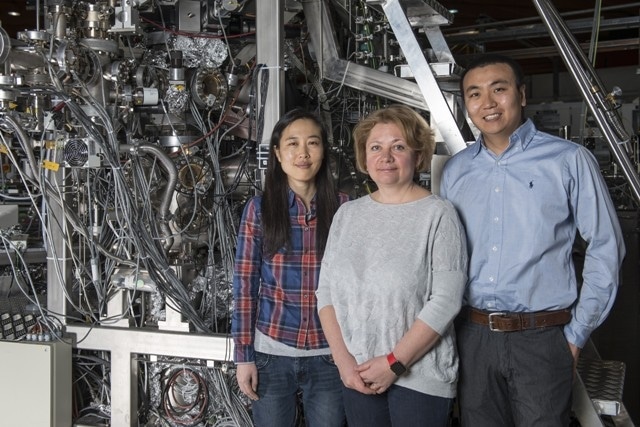Mar 18 2016
The Weyl fermion, just discovered in the past year, moves through materials practically without resistance. Now researchers are showing how it could be put to use in electronic components.
 Three members of the PSI research team that studied the pssoibilities of using Weyl fermions in electronic devices. The picture was taken at the SIS beamline at the Swiss Light Source SLS. From left to right: Jihwey Park, Ekaterina Pomjakushina, Nan Xu. (Photo: Paul Scherrer Institut/Mahir Dzambegovic)
Three members of the PSI research team that studied the pssoibilities of using Weyl fermions in electronic devices. The picture was taken at the SIS beamline at the Swiss Light Source SLS. From left to right: Jihwey Park, Ekaterina Pomjakushina, Nan Xu. (Photo: Paul Scherrer Institut/Mahir Dzambegovic)
Today electronic devices consume a lot of energy and require elaborate cooling mechanisms. One approach for the development of future energy-saving electronics is to use special particles that exist only in the interior of materials but can move there practically undisturbed. Electronic components based on these so-called Weyl fermions would consume considerably less energy than present-day chips. That’s because up to now devices have relied on the movement of electrons, which is inhibited by resistance and thus wastes energy. Evidence for Weyl fermions was discovered only in the past year, by several research teams including scientists from the Paul Scherrer Institute PSI. Now PSI researchers have shown — within the framework of an international collaboration with two research institutions in China and the two Swiss technical universities, ETH Zurich and EPF Lausanne — that there are materials in which only one kind of Weyl fermion exists. That could prove decisive for applications in electronic components, because it makes it possible to guide the particles’ flow in the material. The researchers report their results in the journal Nature Communications.
In the past year, researchers of the Paul Scherrer Institute PSI were among those who found experimental evidence for a particle whose existence had been predicted in the 1920s — the Weyl fermion. One of the particle’s peculiarities is that it can only exist in the interior of materials. Now the PSI researchers, together with colleagues at two Chinese research institutions as well as at ETH Zurich and EPF Lausanne, have made a subsequent discovery that opens the possibility of using the movement of Weyl fermions in future electronic devices. Such devices would be considerably smaller and more energy-efficient than their present-day counterparts.
Today’s computer chips use the flow of electrons that move through the device’s conductive channels. Because, along the way, electrons are always colliding with each other or with other particles in the material, a relatively high amount of energy is needed to maintain the flow. That means not only that the device wastes a lot of energy, but also that it heats itself up enough to necessitate an elaborate cooling mechanism, which in turn requires additional space and energy.
In contrast, Weyl fermions move virtually undisturbed through the material and thus encounter practically no resistance. “You can compare it to driving on a highway where all of the cars are moving freely in the same direction,” explains Ming Shi, a senior scientist at the PSI. “The electron flow in present-day chips is more comparable to driving in congested city traffic, with cars coming from all directions and getting in each other’s way.”
Important for electronics: only one kind of particle
While in the materials examined last year there were always several kinds of Weyl fermions, all moving in different ways, the PSI researchers and their colleagues have now produced a material in which only one kind of Weyl fermion occurs. “This is important for applications in electronics, because here you must be able to precisely steer the particle flow,” explains Nan Xu, a postdoctoral researcher at the PSI.
Weyl fermions are named for the German mathematician Hermann Weyl, who predicted their existence in 1929. These particles have some striking characteristics, such as having no mass and moving at the speed of light. Weyl fermions were observed as quasiparticles in so-called Weyl semimetals. In contrast to “real” particles, quasiparticles can only exist inside materials. Weyl fermions are generated through the collective motion of electrons in suitable materials. In general, quasiparticles can be compared to waves on the surface of a body of water — without the water, the waves would not exist. At the same time, their movement is independent of the water’s motion.
The material that the researchers have now investigated is a compound of the chemical elements tantalum and phosphorus, with the chemical formula TaP. The crucial experiments were carried out with X-rays at the Swiss Light Source SLS of the Paul Scherrer Institute.
Studying novel materials with properties that could make them useful in future electronic devices is a central research area of the Paul Scherrer Institute. In the process, the researchers pursue a variety of approaches and use many different experimental methods.